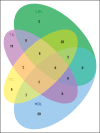Progress in genetic association studies of plasma lipids
- PMID: 23385652
- PMCID: PMC4222789
- DOI: 10.1097/MOL.0b013e32835df2d6
Progress in genetic association studies of plasma lipids
Abstract
Purpose of review: This review summarizes recently published large-scale efforts elucidating the genetic architecture of lipid levels. A supplemental file with all genetic loci is provided for research purposes and we performed bioinformatic analyses of the genetic variants to give an oversight of involved pathways.
Recent findings: In total, 52 genes for HDL cholesterol, 42 genes for LDL cholesterol, 59 genes for total cholesterol, and 39 genes for triglycerides have been identified. Genetic overlap is present between the different traits and similar pathways are involved. Most of the SNPs that were detected in the European studies could be replicated in other ethnicities and these SNPs show the same direction of effect suggesting that the underlying genetic architecture of blood lipids is similar between ethnicities.
Summary: Genetic studies have identified many loci associated with plasma lipids and have provided insight into the underlying mechanisms of lipid homeostasis. Future research is needed to determine whether these loci may be novel targets for lipid-lowering therapy and for reducing cardiovascular disease risk. In addition, the proportion of genetic variance explained by these lipid loci is still limited and new large-scale genetic studies are ongoing to identify additional common and rare variants associated with lipid levels.
Figures



Similar articles
-
Racial/ethnic variation in the association of lipid-related genetic variants with blood lipids in the US adult population.Circ Cardiovasc Genet. 2011 Oct;4(5):523-33. doi: 10.1161/CIRCGENETICS.111.959577. Epub 2011 Aug 10. Circ Cardiovasc Genet. 2011. PMID: 21831959
-
Large-scale gene-centric meta-analysis across 32 studies identifies multiple lipid loci.Am J Hum Genet. 2012 Nov 2;91(5):823-38. doi: 10.1016/j.ajhg.2012.08.032. Epub 2012 Oct 11. Am J Hum Genet. 2012. PMID: 23063622 Free PMC article.
-
The Combined Effect of Common Genetic Risk Variants on Circulating Lipoproteins Is Evident in Childhood: A Longitudinal Analysis of the Cardiovascular Risk in Young Finns Study.PLoS One. 2016 Jan 5;11(1):e0146081. doi: 10.1371/journal.pone.0146081. eCollection 2016. PLoS One. 2016. PMID: 26731281 Free PMC article.
-
Blood lipid profiles and risk of atrial fibrillation: A systematic review and meta-analysis of cohort studies.J Clin Lipidol. 2020 Jan-Feb;14(1):133-142.e3. doi: 10.1016/j.jacl.2019.12.002. Epub 2019 Dec 20. J Clin Lipidol. 2020. PMID: 31926850
-
Genetic determinants of inherited susceptibility to hypercholesterolemia - a comprehensive literature review.Lipids Health Dis. 2017 Jun 2;16(1):103. doi: 10.1186/s12944-017-0488-4. Lipids Health Dis. 2017. PMID: 28577571 Free PMC article. Review.
Cited by
-
SHBG gene polymorphism (rs1799941) associates with metabolic syndrome in children and adolescents.PLoS One. 2015 Feb 3;10(2):e0116915. doi: 10.1371/journal.pone.0116915. eCollection 2015. PLoS One. 2015. PMID: 25647406 Free PMC article.
-
Association of Atherogenic Index of Plasma with Cardiometabolic Risk Factors and Markers in Lean 14-to-20-Year-Old Individuals: A Cross-Sectional Study.Children (Basel). 2023 Jun 30;10(7):1144. doi: 10.3390/children10071144. Children (Basel). 2023. PMID: 37508640 Free PMC article.
-
Serum cholesterol and variant in cholesterol-related gene CETP predict white matter microstructure.Neurobiol Aging. 2014 Nov;35(11):2504-2513. doi: 10.1016/j.neurobiolaging.2014.05.024. Epub 2014 Jun 2. Neurobiol Aging. 2014. PMID: 24997672 Free PMC article.
-
Genetic susceptibility, dietary cholesterol intake, and plasma cholesterol levels in a Chinese population.J Lipid Res. 2020 Nov;61(11):1504-1511. doi: 10.1194/jlr.RA120001009. Epub 2020 Aug 12. J Lipid Res. 2020. PMID: 32817344 Free PMC article.
-
Prediction of Blood Lipid Phenotypes Using Obesity-Related Genetic Polymorphisms and Lifestyle Data in Subjects with Excessive Body Weight.Int J Genomics. 2018 Nov 19;2018:4283078. doi: 10.1155/2018/4283078. eCollection 2018. Int J Genomics. 2018. PMID: 30581838 Free PMC article.
References
-
- Heller DA, de Faire U, Pedersen NL, et al. Genetic and environmental influences on serum lipid levels in twins. N Engl J Med 1993; 328:1150–1156. - PubMed
-
- Asselbergs FW, Guo Y, van Iperen EP, et al. Large-scale gene-centric meta-analysis across 32 studies identifies multiple lipid loci. Am J Hum Genet 2012; 91:823–838. - PMC - PubMed
-
This large-scale effort identified 21 novel loci and included more than 65 000 individuals. The largest effort since GLGC.
Publication types
MeSH terms
Substances
LinkOut - more resources
Full Text Sources
Other Literature Sources
Medical
Research Materials

